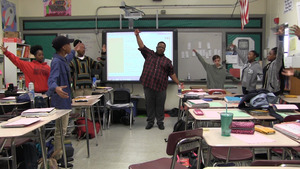By Public Impact®, April 3, 2020
During this unprecedented crisis, the right schedules, along with videoconferencing, can help keep students and educators emotionally connected, while ensuring continued instructional excellence by teaching teams.
Public Impact® has created new schedule examples for at-home learning, either full-day or half-day, for elementary and secondary school Opportunity Culture® multi-classroom leader teams and their students. These materials will help schools provide students with face-to-face connections with each teacher and classmates, optimize use of other online learning, limit total screen time, and provide flexibility for when technology shortcomings and family disruptions affect students.
Read: Multi-Classroom Leadership + Team Reach Elementary Schedule Example for At-Home Learning
Multi-Classroom Leadership + Team Reach Secondary Schedule Example for At-Home Learning
On the Ground: Reflections from Opportunity Culture® Educators on At-Home Teaching and Leading
Over the past week and a half, Public Impact®’s Sharon Kebschull Barrett has interviewed many current and past Opportunity Culture® Fellows about their shifts to at-home learning—what’s going well, what worries them, and what tips they have for other Opportunity Culture® educators and districts.
Use this link to find these stories of how great teachers adapted in the early weeks after school closures—four columns so far, with more to come next week, including some from Opportunity Culture® principals.
Opportunity Culture® Fellows are chosen for their leadership and success helping students make high learning growth. But more than anything right now, these educators miss and worry about their students. They have connected with every student they possibly can (and worry greatly about the few they haven’t reached), and say their first concern was students’ food and safety. Many praised their districts for quickly replacing school breakfasts and lunches—and distributing technology for teaching and learning from home.
After taking care of basics, these great educators are back to focusing on helping students achieve their learning potential. Here are some of their tips for other educators—read their full stories for more:
Connect—and Be Forgiving
Give extra grace: Multi-classroom leaders (MCLs) and principals see the stress on their teaching teams, and everyone sees the stress on their students. Teachers want to keep up their high-standards instruction, but over and over, interviewees emphasized the need to be understanding and cut everyone extra slack as they deal with fear and frustration.
Stay focused on relationships: “The biggest thing long-term for me is relationship-building,” Candace Butler said. “I’ve said it from the beginning and I’ll say it til the end—we have to keep building the relationship…not only with the students, but also with the parents and the community because we need everybody’s support in order to make sure that our students are getting exactly what they need.” (Watch for more at OpportunityCulture.org/blog next week about Butler.)
Keep Doing What Works
.jpg) Maintain what you did well throughout the year: After spring break, MCL Tu Willingham will begin observing and coaching his team while they teach online. His routines of coaching, co-teaching, modeling, and leading the team in data analysis really shouldn’t change if school stays remote, he says; the main work is shifting strong in-person instruction to strong distance instruction. All interviewees agreed: MCL Fred Hoffmann, for example, said teachers should rely on their good, direct instruction that they already were doing. (See Public Impact®’s summary of how to maintain the instructional excellence elements that top Opportunity Culture® educators demonstrate.)
Maintain what you did well throughout the year: After spring break, MCL Tu Willingham will begin observing and coaching his team while they teach online. His routines of coaching, co-teaching, modeling, and leading the team in data analysis really shouldn’t change if school stays remote, he says; the main work is shifting strong in-person instruction to strong distance instruction. All interviewees agreed: MCL Fred Hoffmann, for example, said teachers should rely on their good, direct instruction that they already were doing. (See Public Impact®’s summary of how to maintain the instructional excellence elements that top Opportunity Culture® educators demonstrate.)
Maintain team meetings: MCLs and principals, maintain your previous schedules of team meetings and individual meetings between MCLs and team teachers. Like Willingham, former MCL (now assistant principal) Erin Burns Mehigan has continued with regular team meetings—now on Zoom—that maintain their focus on data-driven instruction. See our new schedule examples to help.
Take care of yourself: When Candace Butler talks to the teachers she supports, she says, “ ‘I care that, one, you’re taking care of yourself because you cannot be productive if you’re not doing self-care… just keep taking care of yourself, because if you break down, then that’s where it’s all going to break down.’ So we have had a couple of “Ahh!” and some, like, scream, cry, let’s get it out, c’mon, we’ll do it together; it’s necessary, you know—it cleanses the soul, and then let’s get back on the horse and let’s ride it, because we’ve got to do it for the students.”
Understand What’s Different, And Adapt
 Survey students to understand their needs, instructionally and emotionally: Expanded-Impact Teacher Jimmel Williams listened to his students’ request for a simplified Canvas platform for their assignments, presented with expandable menus that keep the workload from appearing overwhelming. His survey also showed him that “they really miss their peers; they miss being able to just laugh and cut up. They’re also very concerned and very anxious.”
Survey students to understand their needs, instructionally and emotionally: Expanded-Impact Teacher Jimmel Williams listened to his students’ request for a simplified Canvas platform for their assignments, presented with expandable menus that keep the workload from appearing overwhelming. His survey also showed him that “they really miss their peers; they miss being able to just laugh and cut up. They’re also very concerned and very anxious.”
On videoconferences, focus on small groups: Williams tried Zoom with larger groups of the 212 students he teaches, but found it chaotic. Small groups work best, for instruction and a time for students to connect with eye contact and smiles—and to have fun.
Limit the number of learning platforms: Although that limits teachers’ autonomy, it helps students who otherwise may now have five platforms to navigate, Willingham said—“like an octopus on roller skates.”
Include not only daily but weekly due dates: Weekly deadlines give students some control of and accountability for their study schedules, while daily ones help teachers check for understanding and address gaps quickly. Keep up the grace, though, understanding that students may have disruptions at home. Give students second and third chances to turn in their work, and reach out to help, rather than just marking work as missing. Williams allows his students to keep trying on assignments until they are satisfied with their mastery.
Communicate, in as many ways as possible, but with one consistent message: Use multiple ways to communicate with parents—email, phone messages, and learning platform messaging—to be sure at least one way reaches them, but consider being even more directive with teaching teams than usual about what goes out. “There’s just so much room for interpretation that we are having to be more explicit than normal, almost like, ‘here is a sample email, copy and paste and insert your name here,’” Mehigan said. “This is so new for everybody, and everyone’s interpretation of what is going on is a little bit different, that it’s just been a big challenge trying to have one message out of the school. … Make sure it’s all uniform.”
What Can Districts Learn from Schools Previously Providing Distance Learning?

The transition forced by COVID-19 to at-home teaching and learning poses many questions for districts. We’re taking a close look at policies of previously established virtual schools, as well as districts that have quickly implemented strong policies. Next week, we’ll share what we learn. Meanwhile, consider addressing these topics in your district’s policies for at-home teaching and learning:
- Teacher time in/out policies
- Student attendance or seat-time policies
- Policies for keeping teachers and students safe in online interactions
- Expectations for teachers’ work hours to teach students, meet with their MCL teams, and respond to messages
- Expectations for face-to-face versus asynchronous learning
- Expectations for providing services for students with special needs (English language learners, special education, etc.)
- Grading policy changes, if any, both temporary and long-term
- Policies on student/employee data management
- Policies on hardware, software, and internet access and maintenance
- Homework completion deadlines and exceptions
- Honor code policies for student assessments to ensure that students pursue mastery
- Opportunities for teacher support and collaboration
Opportunity Culture® Districts Keep On Keeping On
Need some good news? We at Public Impact® have noticed how, as Opportunity Culture® districts move swiftly to at-home teaching and learning, they are also staying on track with planning for fall 2020 and supporting their MCLs, reach teachers, reach associates, and principals. Here are a few examples from Lucy Steiner, Public Impact®’s senior vice president for educator excellence and implementation services, and the team working directly with Opportunity Culture® districts:
- School design teams in two Texas districts—Ector County ISD and Midland ISD—made their final school design presentations remotely last week—the districts have enthusiasm and momentum! Both districts continue to accept and review applications for Opportunity Culture® positions.
- In Guilford County Schools (North Carolina), planning continues for more schools to implement Opportunity Culture® in the fall, along with coaching support for multi-classroom leaders from Public Impact®.
- Ten Memphis schools from several charter organizations are planning for fall Opportunity Culture® implementation, and have continued their hiring processes remotely over the past few weeks.
- Chicago Public Schools held its second school design session remotely earlier this week and is accepting and reviewing applications for MCLs now.
- The Arkansas Department of Education is leading district design work in 16 schools.
- Hertford County Schools (North Carolina) has opened its pool for candidates to apply for Opportunity Culture® positions and will begin interviews next week.
- North Little Rock, Arkansas, schools are rethinking professional learning for MCLs to address at-home teaching and learning.
- Vance County Schools (North Carolina) continues planning to implement Opportunity Culture® in more schools this fall.
Note: Public Impact® and Opportunity Culture® are registered trademarks; Multi-Classroom Leader®, MCL™, Multi-Classroom Leadership™, Reach Associate™, Team Reach™, and Expanded-Impact Teacher™ are trademarked terms, registration pending.
